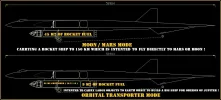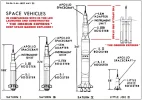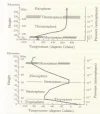Install the app
How to install the app on iOS
Follow along with the video below to see how to install our site as a web app on your home screen.
Note: This feature may not be available in some browsers.
You are using an out of date browser. It may not display this or other websites correctly.
You should upgrade or use an alternative browser.
You should upgrade or use an alternative browser.
Avaruus
- Viestiketjun aloittaja Juke
- Aloitus PVM
Cassinin reitti on tuollainen siksi että sillä piti päästä kahden ison planeetan luon samalla kertaa.
No ei vaan siksi, että tuo touhu ei ole suoraan pisteestä A pisteeseen B lentelyä kuten ilmailu maassa.
Mars reconnaissance orbiterin matka marsiin vei 7,5kk. Nopeus oli jonkinverran pakonopeuden yläpuolella atlaksen viimeisen vaiheen sammuttua. Luotaimen saavuttua marsiin nopeus oli enään 2,9km/sek. Silti nopeutta piti pudottaa poltolla kilometri sekunnissa marsin kiertoradan saavuttamiseksi.
Tässä koko keskustelussa ollaan alun alkaen täysin hakoteillä, kun kuvitellaan kahden planeetan ratojen etäisyyden olevan se matkaetäisyys. Tai jos ajatellaan jonkun tietyn nopeuden olevan sen koko matkan keskinopeus. Tai täysin utopistisia nopeuksia, joita ei millään nykytekniikalla voida saavuttaa edes luotaimille.
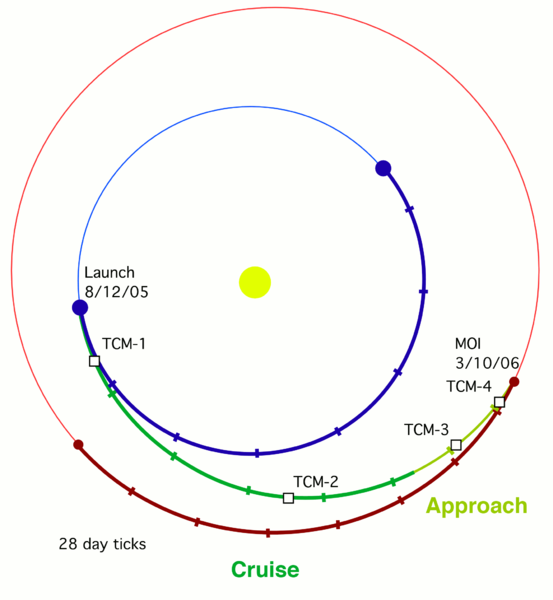
vehamala
Kenraali
No ei vaan siksi, että tuo touhu ei ole suoraan pisteestä A pisteeseen B lentelyä kuten ilmailu maassa.
.....
Tässä koko keskustelussa ollaan alun alkaen täysin hakoteillä, kun kuvitellaan kahden planeetan ratojen etäisyyden olevan se matkaetäisyys. Tai jos ajatellaan jonkun tietyn nopeuden olevan sen koko matkan keskinopeus.
Tai täysin utopistisia nopeuksia, joita ei millään nykytekniikalla voida saavuttaa edes luotaimille.
Joo, olet oikeassa. Nuo planeettaluotaimien radat ovat ym. kuvan kaltaisia, eivät ratojen keskinäisiä etäisyyksiä.
Ja tuon (keski)nopeustekijän takia aikaisemmin kyselin niiden voimanlähteiden perään.
Toistaiseksi ei ole olemassa järkevää tekniikkaa matkailla (edes) aurinkokunnassa.
[/quote]No ei vaan siksi, että tuo touhu ei ole suoraan pisteestä A pisteeseen B lentelyä kuten ilmailu maassa.
Mars reconnaissance orbiterin matka marsiin vei 7,5kk. Nopeus oli jonkinverran pakonopeuden yläpuolella atlaksen viimeisen vaiheen sammuttua. Luotaimen saavuttua marsiin nopeus oli enään 2,9km/sek. Silti nopeutta piti pudottaa poltolla kilometri sekunnissa marsin kiertoradan saavuttamiseksi.
Tässä koko keskustelussa ollaan alun alkaen täysin hakoteillä, kun kuvitellaan kahden planeetan ratojen etäisyyden olevan se matkaetäisyys. Tai jos ajatellaan jonkun tietyn nopeuden olevan sen koko matkan keskinopeus. Tai täysin utopistisia nopeuksia, joita ei millään nykytekniikalla voida saavuttaa edes luotaimille.

Winsu puhuu ihan höpöjä nopeuksista...250 000 km/h on Helioksen nopeus...se on 70 km/s. Se on selvä, että venkura pitää tehdä lopussa jotta pääsee radalle..mutta suorinta tietä pyritään pääsemään aina. Voin olla väärässäkin...sillä pientä kurvaa ilmeisesti tarvitaan lähiplaneetoille...entä Neptunus ajaisitko sinnekin kaarta pitkin ?
Mielestäni pitäisi päästä aiheeseen pikkuhiljaa...miksi avaruudenvalloitus on pysähtynyt...eikö Challengerin ja Columbian räjähdyksen ohi olla päästy vieläkään ? Onko kyse pelosta ?
Onko nasalla vain kirjaviisaita nyhveröitä töissä ?
Viimeksi muokattu:
Otetaan esimerkki...aiomme matkata 3,5 vuotta Neptunuksen kuulle Tritonille joka pyörii 4.5 km/s vastapäivään kuin Neptunus pyörii auringon ympäri...miten laskeudut sinne jos Neptunus pyörii auringon ympäri 5.5 km/s ?
http://library.thinkquest.org/28327/html/universe/solar_system/planets/neptune/moons/triton.html
http://fi.wikipedia.org/wiki/Neptunus
Jup..ilmeisesti suoraan ajaminen onnistuu vain jos ajaa kuulle joka pyörii huomattavasti nopeampaa kuin itse planeetta jota se kiertää ???
Jupiterin Themis liikkuu 17 km/s..miten sinne samoilla ehdoilla ?
http://en.wikipedia.org/wiki/24_Themis
Jupiter itse liikkuu 13 km/s; http://en.wikipedia.org/wiki/Jupiter
http://library.thinkquest.org/28327/html/universe/solar_system/planets/neptune/moons/triton.html
http://fi.wikipedia.org/wiki/Neptunus
Jup..ilmeisesti suoraan ajaminen onnistuu vain jos ajaa kuulle joka pyörii huomattavasti nopeampaa kuin itse planeetta jota se kiertää ???
Jupiterin Themis liikkuu 17 km/s..miten sinne samoilla ehdoilla ?
http://en.wikipedia.org/wiki/24_Themis
Jupiter itse liikkuu 13 km/s; http://en.wikipedia.org/wiki/Jupiter
Viimeksi muokattu:
...miten laskeudut sinne...?
No miten olisi vaikka ihan samalla lailla, kuin kaikille muillekin taivaankappaleille laskeutumiset?
Maapallon nopeus radallaan on moninkertainen, 29,78km/sek. Miten tänne laskeuduttiin kuussa käynnin jälkeen? Kannattaisi muuten edes ymmärtää lukemansa lähteet, tritonin pyörähdysaika on yli 5 maan vuorokautta. Sen kokoisella pallolla se tekee ekvaattorin pyörimisnopeudeksi mitä?
Ihminen on saanut laitteita tähän mennessä laskettua pehmeästi venukseen, marsiin, kuuhun, titaniin, asteroidille ja onpa komeettakin ohitettu lähietäisyydeltä. Kaikki ratanopeuksiltaan ja painovoimiltaan varsin paljon toisistaan poikkeavia. Kuuta lukuunottamatta kaikkiin edellämainittuihin paikkoihin lähetettyjen laitteiden nopeus on ollut välillä 11.186- 16,5km/sek heti laukaisun jälkeen.
Ihan oikeasti Juke, kaikki tämä löytyy netistä kymmenistä luotettavista lähteistä. Jokikisen laukaistun aluksen alkunopeudet ja lentoradat on löydettävissä yksinkertaisilla hakusanoilla. Etenkin viimeisimpien luotainten nopeuksista on yksityiskohtaista tietoa lennon eri vaiheissa Mm. Cassini ja MRO. Taivaankappaleiden välinen matkailu ja siihen liittyvät fysiikan lait väännetään rautalangasta kymmenillä ja taas kymmenillä sivustoilla. Peruskoululainenkin tietää miten kappale kiertää aurinkoa ja siihen liittyvät lainalaisuudet.
Silti...kaikesta huolimatta...Juke ei viitsi tarkistaa edes perusasioita asioista, joista kirjoittaa kieli poskella täysin päättömiä lukuja ja kääntää yli vuosisadan tunnetut aiheeseen liittyvät lainalaisuudet täysin päälaelleen. Miksi tämä on jo jotenkin niin tuttua? Montako viestiä tätäkin viestiketjua kesti, kunnes ne hatusta vetäistyt luvut ja laskelmat ja lentokonepiirrustukset tulivat mukaan? Sitten kun mukaan yrittää tuoda hieman realismia ja faktaa, niin...niin...taas kerran joku muu ei ymmärrä kun puuppolaan voidaan leijailla lentokoneella sen verran kaukaa ja jonkin taivaankappaleen nopeus on semmoinen radallaan ja kaikkea muuta varsinaiseen kysymykseen täysin liittymätöntä. Jotenkin tuli semmoinen fiilis, että tämäkin aihe aloitettiin taas kerran pienenä tekosyynä päästä taas kerran postaamaan niitä lentokonepiirustuksia.
Viimeksi muokattu:
Hyvä winsu..mollaa vaan...mutta Helios II liikkuu/lentää edelleen 70 km/s !
Laskeppa yhteen Jupiterin kuun Themiksen ja Jupiterin kiertonopeudet....ja jos maan radalta irtoaa 30 km/s..jos radat etukäteen laskettu oikein niin..miltä näyttää tilanne ?
Lupaan olla jatkossa postaamatta yhtään kuvaa jos ne noin risoo...ne vie vain energiaani.
Niin ja avaruutta tuskin tullaan valloittamaan miehitettynä jos edelleen yritetään 60-luvun teknologioilla selvitä.
Tässä mennään nyt; http://www.mars-one.com/ ...mitä luulette onnistuuko ?
Laskeppa yhteen Jupiterin kuun Themiksen ja Jupiterin kiertonopeudet....ja jos maan radalta irtoaa 30 km/s..jos radat etukäteen laskettu oikein niin..miltä näyttää tilanne ?
Lupaan olla jatkossa postaamatta yhtään kuvaa jos ne noin risoo...ne vie vain energiaani.
Niin ja avaruutta tuskin tullaan valloittamaan miehitettynä jos edelleen yritetään 60-luvun teknologioilla selvitä.
Tässä mennään nyt; http://www.mars-one.com/ ...mitä luulette onnistuuko ?
Viimeksi muokattu:
Tässä todistelin että Solar Eagle itseasiassa kykenee lentämään 140 km korkeudessa;
I'll do some math for you.
L=½pv^2ACl = > ½x0.0000009kg/m3x38098384x1290x3 = 66348 N ....which means an object with Cl 3 flying at 140 km can weigh 6635 kilos ( with 1290 m2 wing area )...now check the centrifugal force in 140km....
12 700 kg (weight with empty fuel in Solar Eagle at 140 km) x a ( a= v^2/r ) = 12700x5.7 = 72843 N .....that means that the plane is forced into orbit with force of 72843 N ie 7284 kg can be reduced from the weight of 12700
...so Solar Eagle with Star Eagle are still cimbing at 140 km !
I'll do some math for you.
L=½pv^2ACl = > ½x0.0000009kg/m3x38098384x1290x3 = 66348 N ....which means an object with Cl 3 flying at 140 km can weigh 6635 kilos ( with 1290 m2 wing area )...now check the centrifugal force in 140km....
12 700 kg (weight with empty fuel in Solar Eagle at 140 km) x a ( a= v^2/r ) = 12700x5.7 = 72843 N .....that means that the plane is forced into orbit with force of 72843 N ie 7284 kg can be reduced from the weight of 12700
...so Solar Eagle with Star Eagle are still cimbing at 140 km !
Hyvä winsu..mollaa vaan...mutta Helios II liikkuu/lentää edelleen 70 km/s !
Alla olevaa kun mietitään hetki oikein tarkasti pitäen mielessä suhteellinen nopeus maan ja auringon välillä, niin ei se helios sitten niin kovaa lähtenytkään meiltä aurinkoa kohden.
Laajentamalla löytyy herkullisimmat osat...
What made the Helios missions so unusual was that the two craft made incredibly close passes to the Sun resulting in very high orbital speeds. These high speeds resulted from the fact that both probes were placed into very elliptical, or eccentric, orbits around the Sun. When a probe is placed into a circular orbit, its speed remains a constant. For example, the Space Shuttle orbits the Earth in a circular or nearly circular orbit at a constant speed of between 17,000 and 18,000 mph (27,355 to 28,960 km/h). When in a highly elliptical orbit, however, a vehicle will reach very high speed when it is close to the body it is orbiting but slow down considerably when it is far away.
The Helios missions both orbited in this manner, with a furthest distance (or aphelion) of nearly 1 Astronomical Unit (AU), which is the distance at which the Earth orbits the Sun. Meanwhile, the closest approach (or perihelion) of the Helios probes was about 0.3 AU. The eccentricity of such an orbit is about 0.54 with a period of about 190 days. The maximum speed of Helios 2, which achieved its perihelion distance of 0.29 AU on 17 April 1976, is quoted as about 150,000 mph (241,350 km/h). By applying some simple equations of orbital mechanics, we can confirm that such an orbit would indeed result in a perihelion velocity of 153,800 mph (247,510 km/h). For comparison, the aphelion speed of Helios 2 turns out to be only 45,360 mph (72,985 km/h) at its farthest distance of 0.983 AU. This massive differential between the vehicle's maximum and minimum speeds graphically illustrates how much an elliptical orbit varies from the circular orbit discussed earlier.
Lähdetään jatkojalostamaan tätä asiaa aurinkokunnan ulkopuolelle suuntaamalla ja sellaisella vekottimella, joka on ihan oikeasti käynyt neptunuksessa. Alla olevissa kuvissa näkyy Voyager kakkosen lentorata ja sen nopeus suhteessa aurinkoon matkansa aikana. Sama vehje joka saattoi heliokset matkaan, antoi alkunopeuden tällekin luotaimelle. Alkunopeus suhteessa maahan oli luokkaa 13-15km/sek.
Aurinkokunnan ulkopuolelle matkaavaan kappaleeseen vaikuttaa hidastavasti lähtöplaneetan ja auringon vetovoima. Kuten kuvasta näkee, voyagerin vauhti hidastui kymmenillä kilometreillä sekunnissa ennenkuin jupiterin painovoima kiihdytti sen nopeutta ennen ohilentoa. Tuon ohilennon jälkeen aurinko ja jupiter olivat hidastavat tekijät. Sama toistui jokaisen ohilennon aikana. Käyrästä näkee myös sen, että noiden "gravity assistien" ansiosta luotain saa riittävän nopeuden matkata noinkin kauas. Ei suinkaan sen maassa laukaistavan raketin vuoksi.
Lentorata ei koskaan ole suora, koska jokikinen kappale aurikokunnassa kiertää aurinkoa. Maasta lähtevällä avaruusaluksella on aina suhteessa aurinkoon maan nopeus kiertoradallaan lisättynä tangentin suuntaisella nopeuden lisäyksellä, joka aiheuttaa maan kiertoradalta erkanevan lentoradan. Aiemmin olevassa MRO:n lentoradassa marsiin näkyy selvästi luotaimen hidastuminen 28 päivän jaksoina.
Tätä samaa painovoimakiihdytyksen periaatetta käytti Cassini ottaessaan vauhtia maan ja venuksen painovoimakentistä kiertäessään auringon kaksi kertaa ennen riittävää vauhtia jupiteriin ja siitä saturnukseen. Kuva reissusta löytyy aikaisemmasta viestistäni. Samaa on tehty kaikkien jupiterin ohittavien luotainten kanssa. Marsiin lentäessä moista ei tarvita, mutta miehitettyyn lentoon liittyvät haasteet ovatkin ihan muualla.
Se taivaankappaleiden välinen matkustaminen ei edelleenkään ole suoraa viivaa kahden kappaleen välillä, eikä nopeus todellakaan ole vakio koko matkan ajan. Aurinkokunnan ulkopuolelle matkaavalla kappaleella se nopeus tosiasiassa hidastuu melkoisesti ajan myötä ilman taivaankappaleiden apua.
Pakonopeus auringosta maan etäisyydellä on muuten 42km/sek. Jos se helios olisi lähtenyt maasta 70km/sek vauhdilla, niin se olisi lentänyt iloisesti aurinkokunnasta ulos. Tosiasiassa sen nopeus suhteessa aurinkoon on 20-70km/sek elliptisellä radalla. Eli helioksen saapuessa maan kiertoradan lähelle nopeus on jopa maan ratanopeutta pienempi. Helioksen huippunopeutta ei antanut sen raketit, vaan raakasti elliptinen kiertorata ja auringon massiivinen vetovoima.
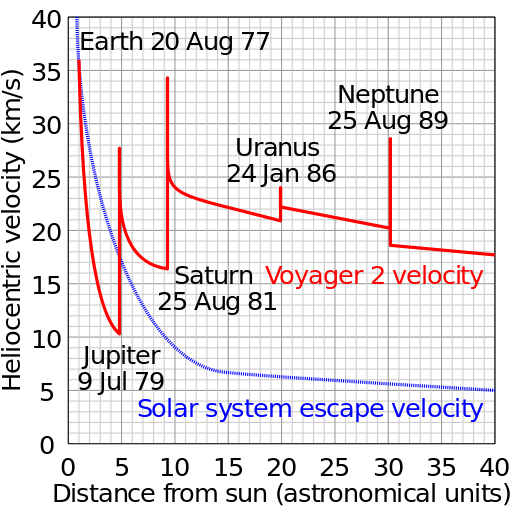

Aurinkokunnan ulkopuolelle matkaavaan kappaleeseen vaikuttaa hidastavasti lähtöplaneetan ja auringon vetovoima. Kuten kuvasta näkee, voyagerin vauhti hidastui kymmenillä kilometreillä sekunnissa ennenkuin jupiterin painovoima kiihdytti sen nopeutta ennen ohilentoa. Tuon ohilennon jälkeen aurinko ja jupiter olivat hidastavat tekijät. Sama toistui jokaisen ohilennon aikana. Käyrästä näkee myös sen, että noiden "gravity assistien" ansiosta luotain saa riittävän nopeuden matkata noinkin kauas. Ei suinkaan sen maassa laukaistavan raketin vuoksi.
Lentorata ei koskaan ole suora, koska jokikinen kappale aurikokunnassa kiertää aurinkoa. Maasta lähtevällä avaruusaluksella on aina suhteessa aurinkoon maan nopeus kiertoradallaan lisättynä tangentin suuntaisella nopeuden lisäyksellä, joka aiheuttaa maan kiertoradalta erkanevan lentoradan. Aiemmin olevassa MRO:n lentoradassa marsiin näkyy selvästi luotaimen hidastuminen 28 päivän jaksoina.
Tätä samaa painovoimakiihdytyksen periaatetta käytti Cassini ottaessaan vauhtia maan ja venuksen painovoimakentistä kiertäessään auringon kaksi kertaa ennen riittävää vauhtia jupiteriin ja siitä saturnukseen. Kuva reissusta löytyy aikaisemmasta viestistäni. Samaa on tehty kaikkien jupiterin ohittavien luotainten kanssa. Marsiin lentäessä moista ei tarvita, mutta miehitettyyn lentoon liittyvät haasteet ovatkin ihan muualla.
Se taivaankappaleiden välinen matkustaminen ei edelleenkään ole suoraa viivaa kahden kappaleen välillä, eikä nopeus todellakaan ole vakio koko matkan ajan. Aurinkokunnan ulkopuolelle matkaavalla kappaleella se nopeus tosiasiassa hidastuu melkoisesti ajan myötä ilman taivaankappaleiden apua.
Pakonopeus auringosta maan etäisyydellä on muuten 42km/sek. Jos se helios olisi lähtenyt maasta 70km/sek vauhdilla, niin se olisi lentänyt iloisesti aurinkokunnasta ulos. Tosiasiassa sen nopeus suhteessa aurinkoon on 20-70km/sek elliptisellä radalla. Eli helioksen saapuessa maan kiertoradan lähelle nopeus on jopa maan ratanopeutta pienempi. Helioksen huippunopeutta ei antanut sen raketit, vaan raakasti elliptinen kiertorata ja auringon massiivinen vetovoima.


Viimeksi muokattu:
vehamala
Kenraali
Ja tuosta Winsun ansiokkaasta esityksestä käyvät myös ilmi mittasuhteet, joiden vuoksi järkevä, miehitetty matkailu ei ole vielä mahdollista edes lähiplaneetoille. Siihen miehitettyyn lentoon tarvitaan paljon muutakin kuin voimanlähde.
Aurinkokunnan ulkopuolelle ei edes kannata unelmoida ennenkuin meillä on laite, joka täyttää melko rajut vaatimukset. Tällaisiahan on jo teorian tasolla suunniteltu. Aluksi voi vaikka arvioida minkäkokoinen tuollainen vehje olisi.
Ja todellakin tuo painovoimalinko on ja on ollut ratkaisevassa roolissa luotaimia kauas lähetettäessä.
Aurinkokunnan ulkopuolelle ei edes kannata unelmoida ennenkuin meillä on laite, joka täyttää melko rajut vaatimukset. Tällaisiahan on jo teorian tasolla suunniteltu. Aluksi voi vaikka arvioida minkäkokoinen tuollainen vehje olisi.
Ja todellakin tuo painovoimalinko on ja on ollut ratkaisevassa roolissa luotaimia kauas lähetettäessä.
Tässä vielä hieman avaruuspiireissä hämmästystä herättänyt työkalucombo jolla Saturnukseen pääsee 400 päivässä ja takaisin samassa ajassa ja tutkimaan kaikki 150 kuuta siellä jos halutaan. Tarvii noin 1500 kiloa kuivamuonaa mukaan..sillä polttoaineen sivutuotteena syntyvä vesi on omasta takaa mukana.
Keinotekoinen painovoima synnytetään pyörivällä liikkeellä Oberon aluksella.
Keinotekoinen painovoima synnytetään pyörivällä liikkeellä Oberon aluksella.
Liitteet
Laite Leolla 160 km korkeudessa koottava ja siten jo 28 000 km/t liikkeessä + maan pyörimisliike 108 0000 km/t ! Eli kyllä lähtee...vaikka Saturnukseen jos vaan rahoitus ja detaljit saadaan hiottua.
Tätä ei ole kukaan kiistänyt etteikö tämä teoriassa ole mahdollista tehdä...huomaa kuinka paljon Apollon 3tta vaihetta se on isompi....ja lähtee ylempää ja nopeammin !
Eli siis pelkästään lähtönopeus jo LEOlta 38 km/s....omaa vauhtiaan voi teoriassa lisätä 47 500 km/t..eli 13.2 km/s..ilman auringosta haettua lisäapua siis 51.2 km/s teoreettinen huippunopeus !...tosin kukin 5stä podista voi vielä itsenäisesti lähteä tuosta raketista 10500 km/t nopeudella...eli 2.9 km/s nopeudella....eli silloin teoriassa jo voitaisiin liikkua 54.1 km/s !
Tätä ei ole kukaan kiistänyt etteikö tämä teoriassa ole mahdollista tehdä...huomaa kuinka paljon Apollon 3tta vaihetta se on isompi....ja lähtee ylempää ja nopeammin !
Eli siis pelkästään lähtönopeus jo LEOlta 38 km/s....omaa vauhtiaan voi teoriassa lisätä 47 500 km/t..eli 13.2 km/s..ilman auringosta haettua lisäapua siis 51.2 km/s teoreettinen huippunopeus !...tosin kukin 5stä podista voi vielä itsenäisesti lähteä tuosta raketista 10500 km/t nopeudella...eli 2.9 km/s nopeudella....eli silloin teoriassa jo voitaisiin liikkua 54.1 km/s !
Liitteet
Viimeksi muokattu:
Juuri luin kun asiasta keskustelin muualla, että itseasiassa ns. suora newtonilainen linja avaruudessa on aina hieman kaarella..käskivät ajatella sitä paperille piirretyksi suoraksi viivaksi joka paperi sitten hieman taitetaan..viiva edelleen suora mutta kaartaa hieman tapauskohtaisesti. Gravitaatiokenttänä se on kuitenkin suora....
Niin kaippa tuo kamaa kiertoradalle nostava koneeni mullistaisi avaruusmatkailun aivan perinjuurin. Vaikea vaan pulliaisen sitä ymmärtää että se nousee korkeammalle kuin mikään lentokone ( tähän mennessä ) x 5 !
Tosta voi tarkistaa että ilmanpainetta riittää hyvin aina 140 km asti ja ylemmäskin.
Niin kaippa tuo kamaa kiertoradalle nostava koneeni mullistaisi avaruusmatkailun aivan perinjuurin. Vaikea vaan pulliaisen sitä ymmärtää että se nousee korkeammalle kuin mikään lentokone ( tähän mennessä ) x 5 !
Tosta voi tarkistaa että ilmanpainetta riittää hyvin aina 140 km asti ja ylemmäskin.
Liitteet
Viimeksi muokattu:
Ideaani Saturnuksen kuulle laskutumisesta pidettiin hyvänä.
http://www.space.com/18477-how-far-away-is-saturn.html
1.2 miljardin kilometrin päässä olevalle planeetalle kestää silti vaikka ajaisi 45 km/s vauhtia niin tollaset 308 päivää sivu.
http://www.space.com/18477-how-far-away-is-saturn.html
1.2 miljardin kilometrin päässä olevalle planeetalle kestää silti vaikka ajaisi 45 km/s vauhtia niin tollaset 308 päivää sivu.
Joo ymmärrän myös että winsu on jossain määrin perehtynyt asiaan tai omaa kiinnostusta siihen. Olen kuitenkin edelleen sitä mieltä että Helios II huippunopeus on 70 km/s ! Winsu väitti aiemmin että tällaiset nopeudet ovat luotaimille mahdottomia.
Sun pitää nyt juke ymmärtää ero nopeuksissa suhteessa toisiin taivaankappaleisiin. Helioksen nopeus auringon ympäri vaihtelee välillä 20-70km/sek. Siis nimenomaan vaihtelee ja se huippunopeus saavutetaan yhtenä ainoana hetkenä ellipsin muotoista rataa pudotessa aurinkoa kohden. Helios luotainten nopeus maan suhteen laukaisun jälkeen ei ollut kuin hieman maan pakonopeuden päälle, luokkaa 11-13m/sek.
Heliokselle riitti hyvin pieni nopeus maan pakonopeuden yli sen saattamiseksi matkalle kohti aurinkoa. Syy tähän on siinä, että kohti aurinkoa matkaavat esineet käytännössä putoavat aurinkoa kohti vetovoiman kiihdyttäessä niiden vauhtia. Helioksen rata on voimakkaasti elliptinen, jolloin sen nopeus perihelionissa on todella suuri ja vastaavasti aphelionissa todella pieni. Itse asiassa sen nopeus hitaimmassa kohdassa on reilusti vähemmän, kuin sen nopeus auringon suhteen laukaisun jälkeen.
Tästä samasta syystä aurinkoa ei voi käyttää hyväksi matkassa kauemmas aurinkokuntaan. Vaikka helios nopeimmillaan kulkee 70km/sek ratansa aurinkoa lähimpänä olevassa kohdassaan, on sen orbitaalinen energia ratansa kauimmaisessa kohdassa paljon pienempi, kuin kauemmas aurinkokuntaan matkaavilla luotaimilla. Vrt. new horizonsin nopeus suhteessa aurinkoon maan tasalla 43km/sek ja helioksen nopeus lähes maan tasalla vain 20km/sek suhteessa aurinkoon.
New Horizons is often given the title of Fastest Spacecraft Ever Launched, although the Helios probes are arguably the holders of that title as a result of speed gained while falling toward the Sun. New Horizons, however, achieved the highest launch velocity and thus left Earth faster than any other spacecraft to date. It is also the first spacecraft launched directly into a solar escape trajectory, which requires an approximate velocity of 16.5 km/s (59,000 km/h; 37,000 mph), plus losses, all to be provided by the launcher. However, it will not be the fastest spacecraft to leave the Solar System. This record is held by Voyager 1, currently travelling at 17.145 km/s (61,720 km/h; 38,350 mph) relative to the Sun. Voyager 1 attained greater hyperbolic excess velocity from Jupiter and Saturn gravitational slingshots than New Horizons. Other spacecraft, such as Helios 1 & 2, can also be measured as the fastest objects, due to their orbital velocity relative to the Sun at perihelion. However, because they remain in solar orbit, their orbital energy relative to the Sun is lower than the five probes, and three other third-stages on hyperbolic trajectories, including New Horizons, that have achieved solar escape velocity, as the Sun has a much deeper gravitational well than Earth.
Alatko nyt jo päästä jyvälle, mikä logiikassasi on mätännyt alusta alkaen? Se raketti ei antanut helios- luotaimille moisia nopeuksia. Tästä ei voida vetää sellaisia johtopäätöksiä, että kauemmas aurinkokuntaan voidaan lentää kovaa, koska helioskin niin teki mutta kohti aurinkoa.
Plutoon matkalla oleva new horizons on nopeimman laukaisun jälkeisen nopeuden saanut laite. Sen nopeus maan suhteen oli 16,5km/sek. Se oli samalla ensimmäinen ihmisen laukaisema luotain, joka saavutti pakonopeuden auringosta maan tasalla eli noin 43km/sek suhteessa aurinkoon. Jupiterin ohilennon kanssakaan siitä ei koskaan tule nopeimmin aurinkokunnasta poistuvaa laitetta, sitä ennätystä pitää hallussaan voyager 1 noin 17.1km/sek vauhdilla suhteessa aurinkoon kirjoitushetkellä. Tämä taas johtuu siitä, että voyager ohitti sekä jupiterin että saturnuksen matkallaan.
Juke tuossa yläpuolella otti puheeksi 50km/sek lähtönopeuden maan kiertonopeuden kanssa. Oletan siis, että puhe oli nopeudesta suhteessa aurinkoon. Tämä on täysin mahdollista suurella raketilla luotaimelle, kyseessähän on vain luokkaa 20km/sek lähtönopeus suhteessa maahan. Puhutaan vain muutamasta kilometristä sekunnissa enemmän nopeutta, kuin new horizons luotaimella. Tässä pitää nyt muistaa se, että se nopeus ei pysy samana koko matkan ajan. Pelkät fysiikan lainalaisuudet tekevät siitä matkasta jotain ihan muuta kuin suoran viivan. Jos sen aluksen nopeus suhteessa aurinkoon on aluksi 50 tai vaikka 60km/sek, niin tuosta nopeudesta lähtee jo pelkästä taivaankappaleiden välisestä mekaniikasta johtuen suurin osa pois ennen edes jupiterin tasan saavuttamista.
1.2 miljardin kilometrin päässä olevalle planeetalle kestää silti vaikka ajaisi 45 km/s vauhtia niin tollaset 308 päivää sivu.
New horizons luotaimen nopeus oli tuo ja sillä meni puolitoista vuotta saavuttaa saturnuksen tasa jupiterin ohilennonkin kanssa.
Viimeksi muokattu:
Winsu nyt ei ole kyse siitä että ymmärränkö minä vaan siitä, että ymmärrätkö sinä !
Mun laite saavuttaa sen 45 km/s heti maan radalta irrottuaan...alkaako nyt kiinnostaa tämä ideoimani kiertoradalla rakennettava laite ?
Huippunopeus on 54.1 km/s ( 194 760 km/t )...mutta sitä käytettäessä ei voi enää pysähtyä koska polttoainetta ei olisi enää jäljellä ( delta-v ). Toki podit voisivat palata maahan kierrettyään Saturnuksen mutta palaisivat ilmakehässä takaisin tullessaan.
Mun laite saavuttaa sen 45 km/s heti maan radalta irrottuaan...alkaako nyt kiinnostaa tämä ideoimani kiertoradalla rakennettava laite ?
Huippunopeus on 54.1 km/s ( 194 760 km/t )...mutta sitä käytettäessä ei voi enää pysähtyä koska polttoainetta ei olisi enää jäljellä ( delta-v ). Toki podit voisivat palata maahan kierrettyään Saturnuksen mutta palaisivat ilmakehässä takaisin tullessaan.
Viimeksi muokattu:


